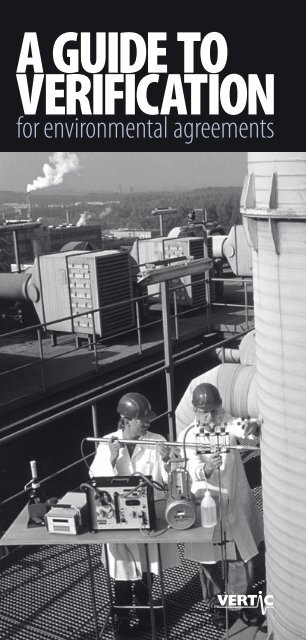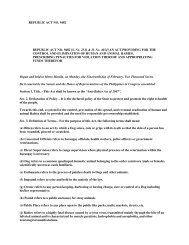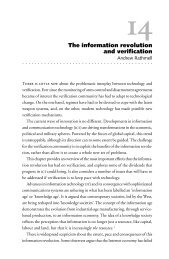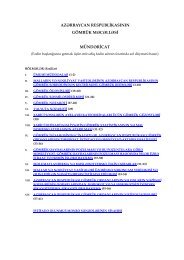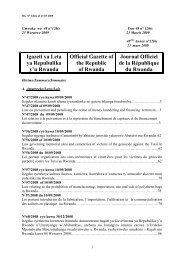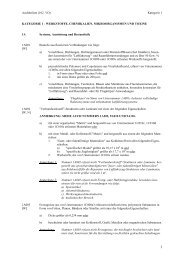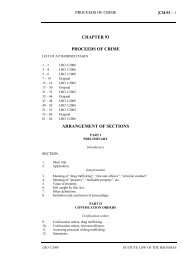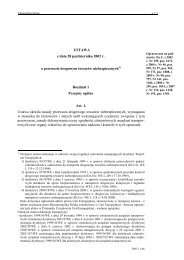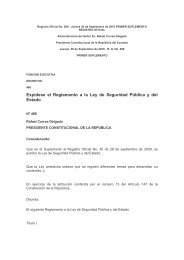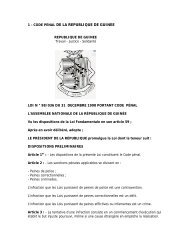A guide to verification for environmental agreements - VERTIC
A guide to verification for environmental agreements - VERTIC
A guide to verification for environmental agreements - VERTIC
You also want an ePaper? Increase the reach of your titles
YUMPU automatically turns print PDFs into web optimized ePapers that Google loves.
A GUIDE TO<br />
VERIFICATION<br />
<strong>for</strong> <strong>environmental</strong> <strong>agreements</strong>
What is <strong>verification</strong>?<br />
Verification is the process of gathering, compiling and interpreting in<strong>for</strong>mation <strong>to</strong><br />
make a judgement on whether parties <strong>to</strong> an agreement are complying with, neglecting<br />
or, in the worst case, cheating on their legal commitments. Verification should confirm<br />
compliance, detect non-compliance and deter potential viola<strong>to</strong>rs.<br />
In <strong>environmental</strong> <strong>agreements</strong> such commitments may involve reducing pollution,<br />
managing wastes, protecting biodiversity or regulating the use of scarce natural resources.<br />
Since <strong>environmental</strong> problems may be subject <strong>to</strong> significant scientific uncertainty, it<br />
may be difficult <strong>to</strong> moni<strong>to</strong>r and verify compliance. Environmental <strong>agreements</strong> thus<br />
tend <strong>to</strong>wards encouraging and assisting states <strong>to</strong> comply, rather than threatening them<br />
with punishment if they do not. Increasingly, however, when such ‘soft’ measures do<br />
not work, consideration is given <strong>to</strong> stronger en<strong>for</strong>cement measures, especially in cases<br />
of deliberate non-compliance.<br />
How does <strong>verification</strong> work?<br />
A <strong>verification</strong> ‘system’ comprises institutions, arrangements, techniques and technologies.<br />
How such elements are designed and combined depends on the specific requirements<br />
of each treaty.<br />
Reporting systems require parties <strong>to</strong> provide in<strong>for</strong>mation on national implementation,<br />
either directly <strong>to</strong> each other or through a designated treaty body. Reporting, which<br />
may be manda<strong>to</strong>ry or voluntary, is often done according <strong>to</strong> a standard <strong>for</strong>mat, by<br />
following <strong>guide</strong>lines or by completing questionnaires.<br />
Moni<strong>to</strong>ring is the collection of in<strong>for</strong>mation on parties’ implementation of their<br />
obligations. e parties themselves undertake such moni<strong>to</strong>ring, but it may also be an<br />
obligation of treaty bodies or even devolved <strong>to</strong> non-governmental organisations (NGOs).<br />
Different techniques may be used <strong>for</strong> gathering data, including on-site inspection,<br />
on-site moni<strong>to</strong>ring and remote sensing.<br />
Reviewing in<strong>for</strong>mation collected is fundamental <strong>to</strong> judging parties’ compliance and<br />
determining how effective an agreement is. is task is normally mandated <strong>to</strong> treaty<br />
bodies, but other international organisations and/or NGOs may be involved.<br />
Compliance and/or en<strong>for</strong>cement measures may be required if a party is found <strong>to</strong> be<br />
violating its obligations. Environmental <strong>agreements</strong> mostly envisage ‘soft’ measures,<br />
such as agreed action plans or financial and technical assistance, but in some cases<br />
they permit <strong>to</strong>ugher penalties, such as fines and sanctions.<br />
Why is <strong>verification</strong> important?<br />
Effective <strong>verification</strong> is a powerful <strong>to</strong>ol <strong>for</strong> building confidence between parties <strong>to</strong> an<br />
agreement. As the economic costs of implementing <strong>environmental</strong> <strong>agreements</strong> may be<br />
substantial, parties will want reassurance that there are no ‘free riders’ among them. By<br />
requiring parties <strong>to</strong> jointly manage <strong>environmental</strong> initiatives, establish a treaty organisation<br />
or simply implement data exchanges, <strong>verification</strong> also promotes cooperation<br />
between the parties. Finally, a <strong>verification</strong> system adds ‘muscle’ <strong>to</strong> an agreement by<br />
permitting continual assessment of its effectiveness and providing data on which <strong>to</strong><br />
base improvements.<br />
Who is involved in <strong>verification</strong>?<br />
Governments initiate, negotiate, sign and ratify, and have ultimate responsibility <strong>for</strong><br />
implementing <strong>environmental</strong> <strong>agreements</strong>. ey collectively determine the strength of<br />
each agreement’s obligations and the robustness of its moni<strong>to</strong>ring, <strong>verification</strong> and<br />
compliance systems. Governments also moni<strong>to</strong>r each others’ compliance using their<br />
own national means.
Verifying . . . trade in endangered species<br />
e 1973 Convention on International Trade in Endangered Species of Wild Fauna and<br />
Flora (CITES) aims <strong>to</strong> protect species of wild animals and plants threatened with extinction<br />
due <strong>to</strong> international trade. e Convention currently lists over 30,000 such species. CITES<br />
subjects international trade <strong>to</strong> controls, such as import and export permits and re-export<br />
certificates issued by national Management Authorities.<br />
Reporting Parties are required <strong>to</strong> report <strong>to</strong> the CITES Secretariat on their trade activities<br />
(annually) and on their legislative, regula<strong>to</strong>ry and administrative ef<strong>for</strong>ts <strong>to</strong> implement the<br />
treaty (biannually). Reporting is facilitated by <strong>guide</strong>lines.<br />
Assessing compliance In<strong>for</strong>mation in national reports is reviewed by the Secretariat, the<br />
Animals and Plants Committees, the Conference of the Parties and in some cases by two<br />
independent organisations, the International Union <strong>for</strong> the Conservation of Nature (IUCN)<br />
and Trade Records Analysis of Fauna and<br />
Flora in Commerce (TRAFFIC). e Secretariat<br />
cooperates with Interpol and the<br />
World Cus<strong>to</strong>ms Organisation in obtaining<br />
additional in<strong>for</strong>mation and may, in certain<br />
circumstances, conduct on-site inspections<br />
<strong>to</strong> confirm compliance. In<strong>for</strong>mation from<br />
annual reports is managed and s<strong>to</strong>red by<br />
the Wildlife Trade Moni<strong>to</strong>ring Unit of<br />
the World Conservation Moni<strong>to</strong>ring<br />
Centre (WCMC).<br />
En<strong>for</strong>cement CITES relies on national<br />
regula<strong>to</strong>ry legislation and, as a last resort,<br />
trade suspensions.<br />
More in<strong>for</strong>mation www.cites.org; and<br />
Rosalind Reeve, ‘Verification mechanisms<br />
in CITES’, Verification Yearbook 2001, <strong>VERTIC</strong>,<br />
London, 2001.<br />
Verifying . . . climate change mitigation<br />
e 1997 Kyo<strong>to</strong> Pro<strong>to</strong>col <strong>to</strong> the 1992 United Nations Framework Convention on Climate<br />
Change (UNFCCC) addresses the threat of global climate change caused by greenhouse gas<br />
emissions originating from human activity. Expected <strong>to</strong> enter in<strong>to</strong> <strong>for</strong>ce in 2003, it establishes<br />
legally binding emission reduction targets <strong>for</strong> developed (Annex I) parties in the<br />
commitment period 2008–2012.<br />
Reporting All parties are encouraged <strong>to</strong> submit periodic National Communications on<br />
their compliance ef<strong>for</strong>ts <strong>to</strong> the UNFCCC Secretariat. Annex I parties are also required <strong>to</strong><br />
submit an annual report on their ef<strong>for</strong>ts <strong>to</strong> implement the Pro<strong>to</strong>col, including an inven<strong>to</strong>ry<br />
of their anthropogenic greenhouse gas emissions and their absorption by sinks.<br />
Assessing compliance e Pro<strong>to</strong>col will have one of the most rigorous compliance regimes<br />
among <strong>environmental</strong> <strong>agreements</strong>. Expert Review Teams, coordinated by the Secretariat,<br />
will analyse all in<strong>for</strong>mation submitted. Implementation questions will be submitted <strong>to</strong> a<br />
Compliance Committee. Its Facilitative Branch will provide advice and assistance <strong>to</strong> parties,<br />
while its En<strong>for</strong>cement Branch will have the power <strong>to</strong> penalise non-compliant parties.<br />
En<strong>for</strong>cement A party that does not meet its reduction target by 2012 will be required <strong>to</strong><br />
make up the difference in the second commitment period (2013–2017) and will be penalised<br />
an extra 30%. It may also have its emissions trading privileges suspended and be required<br />
<strong>to</strong> prepare an action plan <strong>to</strong> bring it in<strong>to</strong> compliance.<br />
More in<strong>for</strong>mation www.unfccc.int; and Molly Anderson, ‘Verification under the Kyo<strong>to</strong><br />
Pro<strong>to</strong>col’, Verification Yearbook 2002, <strong>VERTIC</strong>, London, 2002.
Treaty bodies facilitate implementation, receive, collate and analyse national reports,<br />
undertake moni<strong>to</strong>ring and <strong>verification</strong>, conduct or coordinate reviews of implementation<br />
and assess compliance. Many <strong>environmental</strong> <strong>agreements</strong> establish such<br />
bodies, including secretariats and subsidiary bodies that provide technical or policy<br />
advice. Examples are:<br />
• Secretariat of the 1989 Convention on the Control of Transboundary Movements of<br />
Hazardous Wastes and their Disposal (Basel Convention): assists parties by receiving,<br />
coordinating and conveying in<strong>for</strong>mation on compliance (www.basel.int/pub/<br />
pro<strong>to</strong>col.html).<br />
• Subsidiary Body on Scientific, Technical and Technological Advice (SBSTTA) <strong>to</strong> the<br />
1992 Convention on Biological Diversity: provides expert advice on implementation<br />
issues (www.biodiv.org/convention/sbstta.asp).<br />
Other international organisations act as <strong>for</strong>ums <strong>for</strong> the exchange of views and<br />
in<strong>for</strong>mation relevant <strong>to</strong> <strong>verification</strong>, as well as initiating cooperative endeavours<br />
and conducting research. Examples are:<br />
• Commission on Sustainable Development: functional commission of the UN<br />
Economic and Social Council (ECOSOC), responsible <strong>for</strong> moni<strong>to</strong>ring and reviewing<br />
progress on implementation of a wide range of <strong>agreements</strong> included in Agenda 21,<br />
agreed at the 1992 Earth Summit in Rio de Janeiro, Brazil (www.un.org/esa/<br />
sustdev).<br />
• United Nations Environment Programme (UNEP): the lead UN agency on <strong>environmental</strong><br />
matters, promotes global awareness and cooperation (www.unep.org).<br />
Scientists act as consultants <strong>to</strong> treaty bodies, advise national governments, and<br />
in<strong>for</strong>m and influence a range of <strong>environmental</strong> stakeholders. Scientific institutes<br />
may support moni<strong>to</strong>ring, <strong>verification</strong> and compliance through research and<br />
development. Examples are:<br />
• European Space Agency (ESA): conducts research, inter alia, in<strong>to</strong> the use of earth<br />
observation satellites <strong>for</strong> <strong>environmental</strong> moni<strong>to</strong>ring (www.esa.int).<br />
• Intergovernmental Panel on Climate Change (IPCC): established by the World<br />
Meteorological Organization and UNEP <strong>to</strong> assess scientific, technical and socioeconomic<br />
in<strong>for</strong>mation on the potential impacts of climate change and options<br />
<strong>for</strong> adaptation and mitigation (www.ipcc.ch).
Non-governmental organisations lobby governments <strong>to</strong> make stronger commitments<br />
and establish better moni<strong>to</strong>ring, <strong>verification</strong> and compliance arrangements;<br />
collect, analyse and disseminate data and conduct research; and seek <strong>to</strong> hold<br />
governments <strong>to</strong> account. Some <strong>agreements</strong> provide <strong>for</strong> NGOs <strong>to</strong> officially assist in<br />
moni<strong>to</strong>ring compliance or providing policy and technical advice. NGOs operate<br />
at international, regional, national and local levels. Examples are:<br />
• Environmental Investigation Agency (EIA): moni<strong>to</strong>rs and exposes non-compliance<br />
in the areas of global climate, endangered species and <strong>for</strong>est protection (www.eiainternational.org).<br />
• Foundation <strong>for</strong> International Environmental Law & Development (FIELD): assists<br />
and advises stakeholders on <strong>environmental</strong> legal issues (www.field.org.uk).<br />
e corporate sec<strong>to</strong>r is an increasingly important partner in moni<strong>to</strong>ring <strong>environmental</strong><br />
<strong>agreements</strong>, under contract from governments, and in participating in<br />
financial mechanisms designed <strong>to</strong> provide incentives <strong>for</strong> <strong>environmental</strong> protection<br />
and enhancement. Examples are:<br />
• British Standards Institution (BSI): undertakes greenhouse gas emissions <strong>verification</strong><br />
worldwide (www.bsi-global.com).<br />
• Société Générale de Surveillance (SGS): provides moni<strong>to</strong>ring services in a variety<br />
of areas, including air, soil and water quality (www.sgs.com).<br />
How <strong>to</strong> strengthen <strong>environmental</strong> <strong>verification</strong><br />
• Ensure universality and political support. All governments should be urged <strong>to</strong> sign<br />
and ratify existing <strong>environmental</strong> treaties, support their effective moni<strong>to</strong>ring and<br />
<strong>verification</strong> and consider the negotiation of new <strong>agreements</strong> where necessary.<br />
Citizens should contact their parliamentary representatives, <strong>for</strong>eign ministries and<br />
<strong>environmental</strong> ministries or agencies <strong>to</strong> express their views and seek in<strong>for</strong>mation.<br />
• Increase levels and targeting of funding. Financial incentives and assistance can<br />
increase involvement by countries that see their priorities as being social and<br />
economic rather than <strong>environmental</strong>. Treaty bodies also need sufficient funding<br />
<strong>to</strong> permit them <strong>to</strong> undertake effective moni<strong>to</strong>ring and <strong>verification</strong>.<br />
• Harmonise reporting. As the number of <strong>environmental</strong> <strong>agreements</strong> grows, governments<br />
are required <strong>to</strong> report on an increasing number of <strong>environmental</strong> indica<strong>to</strong>rs.<br />
is stretches national resources and capabilities, particularly in developing<br />
‘We have over 500 international<br />
and regional <strong>agreements</strong>, treaties<br />
and deals covering everything<br />
from the protection of the ozone<br />
layer <strong>to</strong> the conservation of the<br />
oceans and seas. Countries have<br />
national laws <strong>to</strong>o but unless they<br />
are complied with, unless they are<br />
en<strong>for</strong>ced, then they are little more<br />
than symbols, <strong>to</strong>kens, paper tigers’<br />
Klaus Toepfer, Executive Direc<strong>to</strong>r, UNEP, World Summit on Sustainable Development<br />
Johannesburg, South Africa, 27 August 2002
countries. Harmonising reporting requirements and compliance mechanisms across<br />
<strong>agreements</strong> can reap synergies and be more cost effective.<br />
• Increase transparency. All parties should be encouraged <strong>to</strong> be more transparent about<br />
<strong>environmental</strong> policies and actions. Treaty bodies also need <strong>to</strong> be transparent about the<br />
way in<strong>for</strong>mation is collected, distributed and used.<br />
• Use technology. Advanced technology can vastly improve moni<strong>to</strong>ring and <strong>verification</strong>;<br />
off-the-shelf technology, creatively used, can lower costs and improve participation by<br />
developing countries.<br />
• Involve NGOs and other elements of civil society as key <strong>environmental</strong> stakeholders. Governments<br />
and treaty organisations can benefit substantially from their commitment, involvement<br />
and expertise.<br />
Further in<strong>for</strong>mation<br />
Publications<br />
Yearbook of International Co-operation on Environment and Development<br />
Fridtjof Nansen Institute, Lysaker, Norway<br />
Earth Negotiations Bulletin<br />
International Institute <strong>for</strong> Sustainable Development, New York, US<br />
Verification Yearbook<br />
Verification Research, Training and In<strong>for</strong>mation Centre (<strong>VERTIC</strong>), London, UK<br />
Organisations<br />
International Institute <strong>for</strong> Environment and Development (IIED), London, UK<br />
www.iied.org<br />
Commission on Sustainable Development (CSD), New York, US<br />
www.un.org/esa/sustdev/index.html<br />
International Network <strong>for</strong> Environmental Compliance and En<strong>for</strong>cement (INECE)<br />
Washing<strong>to</strong>n DC, US, www.inece.org<br />
Center <strong>for</strong> International Environmental Law (CIEL), Washing<strong>to</strong>n DC, US<br />
www.ciel.org<br />
United Nations Environment Programme (UNEP), Nairobi, Kenya, www.unep.org<br />
Verification Research, Training and In<strong>for</strong>mation Centre (<strong>VERTIC</strong>), London, UK<br />
www.vertic.org<br />
<strong>VERTIC</strong> is an independent, non-profit making, non-governmental organisation. Its mission is <strong>to</strong> promote<br />
effective and efficient <strong>verification</strong> as a means of ensuring confidence in the implementation of international<br />
<strong>agreements</strong> and intra-national <strong>agreements</strong> with international involvement.<br />
<strong>VERTIC</strong>, Baird House, 15–17 St. Cross Street, London EC1N 8UW, United Kingdom<br />
Phone +44.(0)20.7440.6960, Fax +44.(0)20.7242.3266, E-mail info@vertic.org, Website www.vertic.org<br />
Guide compiled by Marita Kivilahti, intern, and Vanessa Chagas, Environment Research Assistant<br />
Design and production Richard Jones, Exile: Design and Edi<strong>to</strong>rial Services (rmjones@onetel.net.uk)<br />
Cover pho<strong>to</strong> Pollution moni<strong>to</strong>ring: two labora<strong>to</strong>ry assistants moni<strong>to</strong>r emissions from the air pipe exhaust of a<br />
chemical production facility in Germany. © Science Pho<strong>to</strong> Library<br />
Pho<strong>to</strong> of CITES inspec<strong>to</strong>rs Kenyan wildlife wardens carry elephant tusks destined <strong>for</strong> illegal export by poachers<br />
whom they apprehended in February 2003. The African elephant is listed under CITES Appendix 1 as one of the<br />
most endangered species. © PA Pho<strong>to</strong>s<br />
ARTEMIS satellite image The ARTEMIS satellite relays data from <strong>environmental</strong> moni<strong>to</strong>ring satellites <strong>to</strong> Europe as<br />
part of its telecommunications payload. © ESA<br />
Pho<strong>to</strong> of Klaus Toepfer Klaus Toepfer is the Executive Direc<strong>to</strong>r of the United Nations Environment Programme (UNEP).<br />
© UNEP Pho<strong>to</strong> Library<br />
Printed by Corporate and Commercial Printing Limited, 5–8 Helmet Row, London, EC1V 3QJ, United Kingdom<br />
© <strong>VERTIC</strong> 2003


